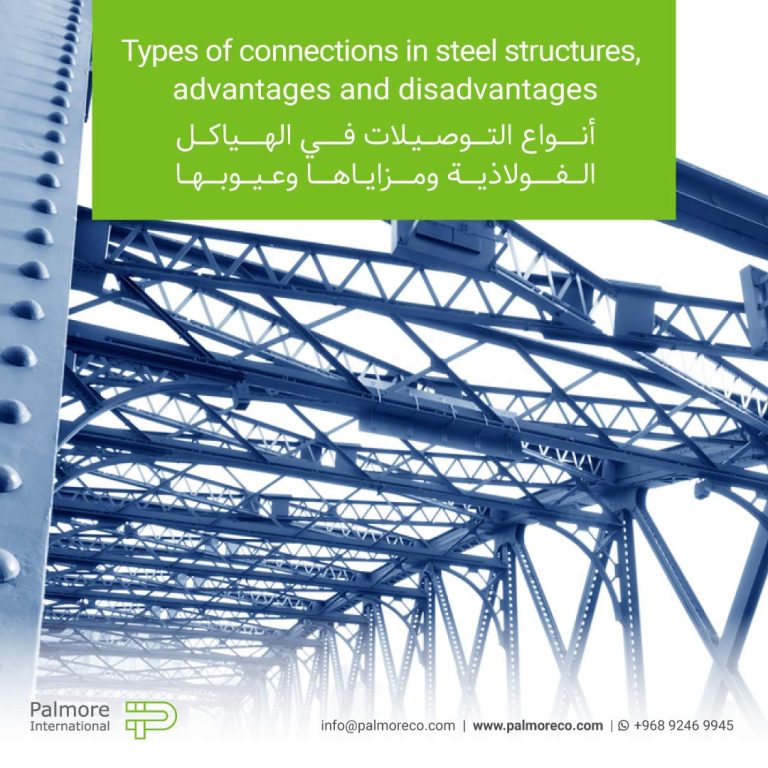
Types of connections in steel structures, advantages and disadvantages ( Part 1 )
Joints are very important in metal or steel structures. Over time, various types of beam-column connection methods have been used in steel frame structures, including rivets, bolts, and welds, each with their own advantages and disadvantages. In the following, these connection methods in steel frame construction are introduced in detail. Fittings in steel structures Steel structures are made with proper connection of existing standard parts. Joints are an important part of a steel structure and are designed with more care than any other load-bearing member.
Fittings in steel structures
Steel structures are made by properly connecting existing standard parts. Joints are an important part of a steel structure and are designed with more care than any other load-bearing part.
There is little difference between the actual behavior and what is happening in the design, so loading and designing complex connections is done a little overhead.
When the connection of a structure loses its ability to carry load in case of overload, as a general rule, its side members come into action, which affects many other members as well.
Most of the cost of steel structure construction is spent on making joints, which is why special attention should be paid to the design of joints for safety and saving in the structure.
In general, the types of connections in metal structures can be summarized in the following categories:
Based on connection tool
Screw
Rivet connection
Normal (A307)
High strength (A325 and A490)
Welded connection
Totally
Corner
Edge
Based on the distribution of internal forces
Bending, rigid or clamped
Flange
Shear, semi-rigid or simple
Corner
One-page or single-sheet
corner sitting
T shape
Axial
brace
truss
Based on the constituent elements
Sheets and corners
Corner sitting
Based on connecting members
Arrow to column
Arrow to arrow
Column by column
Column floor (column page)
Based on the implementation method
Industrial (in workshop)
On-site (at the project site)
Applications of various joints in metal structures
When there is a need to build tall structures with high load-bearing capacity, several prefabricated pieces are used to build structural members. In this case, the various parts are joined together by joints to create a solid and solid member.
In structures with long spans, different parts are provided in standard lengths and are connected to each other by joints. In this case, connecting several pieces to each other requires proper design of the joints.
When it is necessary to connect several members in the end parts of the structure. For example, to connect the side beams to the main beams, columns, floors, etc., suitable connections must be used.
Types of fittings in steel structures
Joints are classified as articulated joints, semi-clamped fittings and clamped fittings.
Clamped connection is a connection that is completely rigid and is not allowed to move in any of the vertical, horizontal and oblique directions for the beam connected to the column and only a moment or anchor is created in it.
This type of connection must have a grip of about 90% or more, which is usually created by the sub-head sheet as a seat and the scarf sheet or, if necessary, the sheet or corner of the life.
A semi-clamped joint is a joint that creates a certain amount of clamping at the abutment and therefore must withstand both shear and anchor force. In this case, the angle rotation between the beam and the column takes place, but its value is less than the articulated state and more than the trapped state.
In a simple or articulated connection, the beam can move freely and without restriction, or create an anchor, and easily assume an angular rotation.
Connections that do not carry anchors are considered in the calculation of beams and columns for a simple support. A simple connection is also called a shear connection because it is used only to transmit shear force.
Rivet connection in steel structures
Rivets are considered to be one of the oldest types of joints in steel structures. In the recent past, all connections of steel structures were made by riveting or welding. Over time, high-strength screws replaced the rivets. Today, rivet fittings are considered almost obsolete.
However, familiarity with this type of connection is essential in order to properly understand the assessment and reconstruction of older structures. The rivet is usually made up of three main components: the cap, the “shank” or the trunk and tail. The structure of the rivet trunk is hollow and it is made of carbon steel or steel with high tensile strength.
Rivets have been a common type of joint for steel structures for many years. They are generally classified as follows:
Hot rivets: Rivets that are driven in hot conditions.
Rivet Shop: Rivets used in the factory.
Workshop rivets: Rivets used at the workshop.
Cold rivets: Rivets that require high air pressure to install.
Disadvantages of using rivet connection and reasons for its obsolescence:
Requires skilled and experienced manpower
High energy consumption and the possibility of fire occurring during riveting due to the need for high heat
The high cost of implementing this type of connection
Low resistance to dynamic loads such as earthquakes
Having a high rate of noise pollution
The high cost of removing a rivet that was improperly installed
Difficulty opening and replacing rivets installed during maintenance operations

